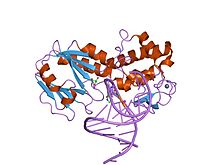H2TH domain
| H2TH | |||||||||
|---|---|---|---|---|---|---|---|---|---|
 crystal structure complex between the lactococcus lactis fpg (mutm) and a fapy-dg containing dna | |||||||||
| Identifiers | |||||||||
| Symbol | H2TH | ||||||||
| Pfam | PF06831 | ||||||||
| Pfam clan | CL0303 | ||||||||
| InterPro | IPR015886 | ||||||||
| PROSITE | PDOC00956 | ||||||||
| SCOP2 | 1k82 / SCOPe / SUPFAM | ||||||||
| |||||||||
In molecular biology, the H2TH domain (helix-2turn-helix domain) is a DNA-binding domain found in DNA glycosylase/AP lyase enzymes, which are involved in base excision repair of DNA damaged by oxidation or by mutagenic agents. Most damage to bases in DNA is repaired by the base excision repair pathway.[1] These enzymes are primarily from bacteria, and have both DNA glycosylase activity EC 3.2.2.- and AP lyase activity EC 4.2.99.18. Examples include formamidopyrimidine-DNA glycosylases (Fpg; MutM) and endonuclease VIII (Nei).
Formamidopyrimidine-DNA glycosylases (Fpg, MutM) is a trifunctional DNA base excision repair enzyme that removes a wide range of oxidation-damaged bases (N-glycosylase activity; EC 3.2.2.23) and cleaves both the 3'- and 5'-phosphodiester bonds of the resulting apurinic/apyrimidinic site (AP lyase activity;EC 4.2.99.18). Fpg has a preference for oxidised purines, excising oxidised purine bases such as 7,8-dihydro-8-oxoguanine (8-oxoG). Its AP (apurinic/apyrimidinic) lyase activity introduces nicks in the DNA strand, cleaving the DNA backbone by beta-delta elimination to generate a single-strand break at the site of the removed base with both 3'- and 5'-phosphates. Fpg is a monomer composed of 2 domains connected by a flexible hinge.[2] The two DNA-binding motifs (a zinc finger and the H2TH (helix-two-turns-helix) motifs) suggest that the oxidised base is flipped out from double-stranded DNA in the binding mode and excised by a catalytic mechanism similar to that of bifunctional base excision repair enzymes.[2] Fpg binds one ion of zinc at the C terminus, which contains four conserved and essential cysteines.[3][4]
Endonuclease VIII (Nei) has the same enzyme activities as Fpg above (EC 3.2.2.-,EC 4.2.99.18), but with a preference for oxidized pyrimidines, such as thymine glycol, 5,6-dihydrouracil and 5,6-dihydrothymine.[5] These proteins contain three structural domains: an N-terminal catalytic core domain, a central helix-two turn-helix (H2TH) module and a C-terminal zinc finger (see PDB:1K82).[6] The N-terminal catalytic domain and the C-terminal zinc finger straddle the DNA with the long axis of the protein oriented roughly orthogonal to the helical axis of the DNA. Residues that contact DNA are located in the catalytic domain and in a beta-hairpin loop formed by the zinc finger.[7]
References
- ^ Fromme JC, Verdine GL (2004). "Base excision repair". Adv. Protein Chem. Advances in Protein Chemistry. 69: 1–41. doi:10.1016/S0065-3233(04)69001-2. ISBN 9780120342693. PMID 15588838.
- ^ a b Sugahara M, Mikawa T, Kumasaka T, Yamamoto M, Kato R, Fukuyama K, Inoue Y, Kuramitsu S (August 2000). "Crystal structure of a repair enzyme of oxidatively damaged DNA, MutM (Fpg), from an extreme thermophile, Thermus thermophilus HB8". EMBO J. 19 (15): 3857–69. doi:10.1093/emboj/19.15.3857. PMC 306600. PMID 10921868.
- ^ O'Connor TR, Graves RJ, de Murcia G, Castaing B, Laval J (April 1993). "Fpg protein of Escherichia coli is a zinc finger protein whose cysteine residues have a structural and/or functional role". J. Biol. Chem. 268 (12): 9063–70. doi:10.1016/S0021-9258(18)52978-1. PMID 8473347.
- ^ Duwat P, de Oliveira R, Ehrlich SD, Boiteux S (February 1995). "Repair of oxidative DNA damage in gram-positive bacteria: the Lactococcus lactis Fpg protein". Microbiology. 141 (2): 411–7. doi:10.1099/13500872-141-2-411. PMID 7704272.
- ^ Doublie S, Bandaru V, Bond JP, Wallace SS (July 2004). "The crystal structure of human endonuclease VIII-like 1 (NEIL1) reveals a zincless finger motif required for glycosylase activity". Proc. Natl. Acad. Sci. U.S.A. 101 (28): 10284–9. Bibcode:2004PNAS..10110284D. doi:10.1073/pnas.0402051101. PMC 478564. PMID 15232006.
- ^ Gilboa R, Zharkov DO, Golan G, Fernandes AS, Gerchman SE, Matz E, Kycia JH, Grollman AP, Shoham G (May 2002). "Structure of formamidopyrimidine-DNA glycosylase covalently complexed to DNA". J. Biol. Chem. 277 (22): 19811–6. doi:10.1074/jbc.M202058200. PMID 11912217.
- ^ Fromme JC, Verdine GL (July 2002). "Structural insights into lesion recognition and repair by the bacterial 8-oxoguanine DNA glycosylase MutM". Nat. Struct. Biol. 9 (7): 544–52. doi:10.1038/nsb809. PMID 12055620. S2CID 38600519.